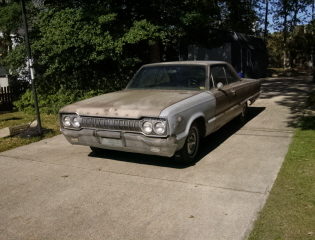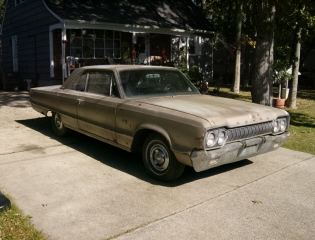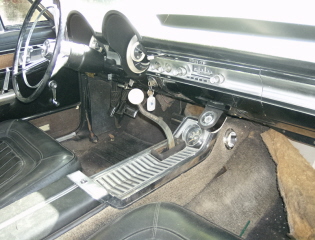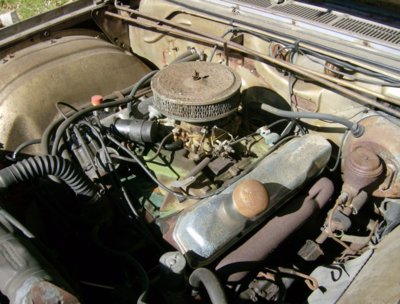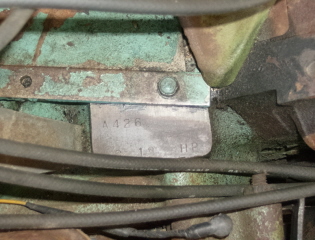Muscle Cars You Should Know: ’70 Plymouth Sport Fury GT 440-6

By Diego Rosenberg July 26, 2011

With the advent of the ’64 Pontiac GTO, thus began the muscle car era. Obviously there were muscular cars before the GTO – as full-size performance cars – from Chevrolet, Dodge and Plymouth, Ford and Mercury, and even Pontiac all competing on America’s streets and strips for a few years already, but the title of “muscle car” seemed to be the sole property of the intermediate-sized machines. And by 1967, full-size performance cars were terribly out of favor.
The Bow Tie boys from Warren, Michigan introduced the 385-horsepower Super Sport 427 package for the ’67 Impala, but that and “regular” 427 full-size cars only numbered several thousand. Both lasted through 1969, with less than 600 of the L72 427/425 being built that year. The top motor option for 1970 was the LS5 454 but no one was buying them to race.

Part of the Fury's appeal was sporty beltlines and sharp curves, but the "large is luxurious" idea. While the Sport Fury GT could be equally equipped as its smaller siblings, the big Plymouth boasted a comfier ride and plusher amenities than the 'Cuda and Road Runner.
The situation was similar for FoMoCo, as only 89 big Fords received the 427 in 1967. For 1968, the 428 Police Interceptor became Top Dog for the full-sized, but 345 horsepower didn’t really cut it on the street.
The new-for-1969 429 Thunder Jet with 360 horsepower turned it into a stump-puller, but it wasn’t very fast. Additionally, Ford never really had a full-size performance model – the XL was merely a trim level with a sporty persona.
Pontiac stopped offering the 2+2 after 1967 (although it continued in Canada through ’70) and the 390-horsepower 428 HO after ’69. The 455 for 1970 wasn’t in the same league.
And up until that time, neither Dodge or Plymouth offered a full-size performance model or package in the 1960s. From 1967 through 1969, it was possible to order a high performance 440 4-barrel in the big Mopars, but they weren’t making news on the street scene, unless it was a cop car hot on your trail.
And then, for 1970, Plymouth introduced the Sport Fury GT.

Introducing the 1970 Rapid Transit System Image: SixPackFuryRegistry.com
It’s a little curious why Plymouth would introduce a full-size muscle car when everyone else had abandoned the segment (and the muscle car market was shrinking besides). However, 1970 was a banner year for muscle cars in general and for Plymouth specifically since they introduced the Rapid Transit System.
“Everybody offers a car. Only Plymouth offers a system,” screamed a period ad. Plymouth felt that anyone could build a car with a big engine, but the System offered a lot more than that: A “total concept in transportation that goes beyond eight pistons and a steering wheel.” The System was all about:

Today, original 440 Six-Barrel equipped Sport Furys are hard to come by. While registries claim only 11 units, production numbers were somewhat higher (only marginally) at 64. Images: Flickr
“Above all, the R.T.S. is the product…a complete high-performance car, with suspension, brakes, driveline, and tires to match.” And as a member of the Rapid Transit System, the Sport Fury with the A52 GT package in its standard form was equipped to do battle:

Although never available with the venerable 426 HEMI elephant, the Sport Fury GT did offer the brand's next most potent powerplant, the 440 Six-Barrel (known to Dodges as the "Six-Pack").
Interestingly, the Super Commando 440 375-horsepower motor – standard on the GTX and available on the ‘Cuda – was neither standard nor available for the Sport Fury GT. However, the 440 six-barrel was a legitimate upgrade. This was the only C-body (internal code for “Mopar big car!”) ever to receive this motor. Fed by three Holley two-barrel carburetors, it was rated at 390 horsepower @ 4700 rpm.
This engine was initially introduced mid-year in 1969 as part of the A12 package for the Road Runner and Super Bee. That package also included a nifty hingeless fiberglass hood that was tested in wind tunnels for air induction efficiency. For 1970, the motor was given general release for most of Mopar’s muscle car offerings but with conventional Mopar hoods and equipment.

Hood stripes of 1970 Sport Fury GT Image: SportFuryGT.com
Like all members of the Rapid Transit System, Plymouth’s designers gave the Sport Fury GT some pop art touches. Reflective strobe stripes wrapped themselves around the car just below the beltline, and the Fury’s subtle hood bulges received accent stripes.
Several High Impact colors were available, including In Violet, Limelight, Lemon Twist, Vitamin C, Tor Red, and – come mid-year – Moulin Rouge and Sassy Grass Green. And since the GT was based on the Sport Fury, it received standard hidden headlights and was trimmed to a higher level.
But when the model year was tallied, only 666 GTs were built. No documentation has been found to determine how many came with the 440 6-bbl., but it’s believed the number was 64. According to the 1970 Sport Fury GT 440-6 Registry, 11 are known.
After a poor showing for 1970, you would think the Sport Fury GT would have disappeared. Instead, Plymouth made it wilder for 1971. Standard power now came from a 370-horsepower Super Commando 440 while the six-barrel option was dropped (although it continued in the ‘Cuda, GTX, and Road Runner).

Somewhat subdued in its styling, the Sport Fury GT did tout some key nods to its sleeker, sportier brethren.
Stripes on the hood were used as an identifier, unlike in 1970, with wide “GT” graphics cradled by pinstripes that spanned the length of the hood. Strobe stripes circling the body were a bit more prominent, and “GT” graphics on the rear quarters looked like they were branded by the men working the line at Lynch Road.
All other changes were across the board for Furys, such as a busier grille and taillights. As part of the Rapid Transit System, the facelifted 1971 Sport Fury GT was in good company with ‘Cudas with “billboard” decals, brand-new Road Runners and GTXs with numerous stripe configurations, and a refreshed Duster 340. And like every performance car sold in 1971, sales were down drastically – only 375 Sport Fury GTs were built.
Plymouth finally got the message about full-size performance cars and quietly laid the Sport Fury GT to rest along with an assortment of other hi-po items in the stable. And while the Rapid Transit System continued on through 1972, it was no longer “the System” that terrorized the tracks and streets but merely an apparition of Plymouth’s former self.

Emasculated "System" for '72 Image: lhmopars.com
By Diego Rosenberg July 26, 2011
With the advent of the ’64 Pontiac GTO, thus began the muscle car era. Obviously there were muscular cars before the GTO – as full-size performance cars – from Chevrolet, Dodge and Plymouth, Ford and Mercury, and even Pontiac all competing on America’s streets and strips for a few years already, but the title of “muscle car” seemed to be the sole property of the intermediate-sized machines. And by 1967, full-size performance cars were terribly out of favor.
The Bow Tie boys from Warren, Michigan introduced the 385-horsepower Super Sport 427 package for the ’67 Impala, but that and “regular” 427 full-size cars only numbered several thousand. Both lasted through 1969, with less than 600 of the L72 427/425 being built that year. The top motor option for 1970 was the LS5 454 but no one was buying them to race.
Part of the Fury's appeal was sporty beltlines and sharp curves, but the "large is luxurious" idea. While the Sport Fury GT could be equally equipped as its smaller siblings, the big Plymouth boasted a comfier ride and plusher amenities than the 'Cuda and Road Runner.
The situation was similar for FoMoCo, as only 89 big Fords received the 427 in 1967. For 1968, the 428 Police Interceptor became Top Dog for the full-sized, but 345 horsepower didn’t really cut it on the street.
The new-for-1969 429 Thunder Jet with 360 horsepower turned it into a stump-puller, but it wasn’t very fast. Additionally, Ford never really had a full-size performance model – the XL was merely a trim level with a sporty persona.
Pontiac stopped offering the 2+2 after 1967 (although it continued in Canada through ’70) and the 390-horsepower 428 HO after ’69. The 455 for 1970 wasn’t in the same league.
And up until that time, neither Dodge or Plymouth offered a full-size performance model or package in the 1960s. From 1967 through 1969, it was possible to order a high performance 440 4-barrel in the big Mopars, but they weren’t making news on the street scene, unless it was a cop car hot on your trail.
And then, for 1970, Plymouth introduced the Sport Fury GT.
Introducing the 1970 Rapid Transit System Image: SixPackFuryRegistry.com
It’s a little curious why Plymouth would introduce a full-size muscle car when everyone else had abandoned the segment (and the muscle car market was shrinking besides). However, 1970 was a banner year for muscle cars in general and for Plymouth specifically since they introduced the Rapid Transit System.
“Everybody offers a car. Only Plymouth offers a system,” screamed a period ad. Plymouth felt that anyone could build a car with a big engine, but the System offered a lot more than that: A “total concept in transportation that goes beyond eight pistons and a steering wheel.” The System was all about:
- Racing in sanctioned events.
- Getting the straight scoop from the factory on “how to tune your car, modify it, which equipment to use, and how to set the whole thing up for racing.”
- Hosting Supercar Clinics conducted by Plymouth’s own racers.
- High-performance parts packaged and available at your local neighborhood Plymouth dealer.
Today, original 440 Six-Barrel equipped Sport Furys are hard to come by. While registries claim only 11 units, production numbers were somewhat higher (only marginally) at 64. Images: Flickr
“Above all, the R.T.S. is the product…a complete high-performance car, with suspension, brakes, driveline, and tires to match.” And as a member of the Rapid Transit System, the Sport Fury with the A52 GT package in its standard form was equipped to do battle:
- High-performance 440cui 350hp Wedge (“economy” versions not available, according to the ad)
- High-performance Carter AVS four-barrel carburetor
- High-flow cylinder heads and intake manifold
- High-upshift TorqueFlite automatic transmission
- Heavy-duty suspension with 0.98″ diameter torsion bars
- Heavy-duty shock absorbers
- Heavy-duty 0.98′ diameter anti-sway bar
- Heavy-duty 6-leaf rear springs
- Heavy-duty 11″ drum brakes
- High-performance dual exhaust system with 2 1/2″ exhaust pipes, twin mufflers, and 2 1/4″ tail pipes
- Heavy-duty driveshaft and U-joint
- Heavy-duty rear axle
- Heavy-duty battery, 70 amp/hr.
- Extra-wide 6″ road wheels
- Fiberglass-belted H70 x 15″ tires
Although never available with the venerable 426 HEMI elephant, the Sport Fury GT did offer the brand's next most potent powerplant, the 440 Six-Barrel (known to Dodges as the "Six-Pack").
Interestingly, the Super Commando 440 375-horsepower motor – standard on the GTX and available on the ‘Cuda – was neither standard nor available for the Sport Fury GT. However, the 440 six-barrel was a legitimate upgrade. This was the only C-body (internal code for “Mopar big car!”) ever to receive this motor. Fed by three Holley two-barrel carburetors, it was rated at 390 horsepower @ 4700 rpm.
This engine was initially introduced mid-year in 1969 as part of the A12 package for the Road Runner and Super Bee. That package also included a nifty hingeless fiberglass hood that was tested in wind tunnels for air induction efficiency. For 1970, the motor was given general release for most of Mopar’s muscle car offerings but with conventional Mopar hoods and equipment.
Hood stripes of 1970 Sport Fury GT Image: SportFuryGT.com
Like all members of the Rapid Transit System, Plymouth’s designers gave the Sport Fury GT some pop art touches. Reflective strobe stripes wrapped themselves around the car just below the beltline, and the Fury’s subtle hood bulges received accent stripes.
Several High Impact colors were available, including In Violet, Limelight, Lemon Twist, Vitamin C, Tor Red, and – come mid-year – Moulin Rouge and Sassy Grass Green. And since the GT was based on the Sport Fury, it received standard hidden headlights and was trimmed to a higher level.
But when the model year was tallied, only 666 GTs were built. No documentation has been found to determine how many came with the 440 6-bbl., but it’s believed the number was 64. According to the 1970 Sport Fury GT 440-6 Registry, 11 are known.
After a poor showing for 1970, you would think the Sport Fury GT would have disappeared. Instead, Plymouth made it wilder for 1971. Standard power now came from a 370-horsepower Super Commando 440 while the six-barrel option was dropped (although it continued in the ‘Cuda, GTX, and Road Runner).
Somewhat subdued in its styling, the Sport Fury GT did tout some key nods to its sleeker, sportier brethren.
Stripes on the hood were used as an identifier, unlike in 1970, with wide “GT” graphics cradled by pinstripes that spanned the length of the hood. Strobe stripes circling the body were a bit more prominent, and “GT” graphics on the rear quarters looked like they were branded by the men working the line at Lynch Road.
All other changes were across the board for Furys, such as a busier grille and taillights. As part of the Rapid Transit System, the facelifted 1971 Sport Fury GT was in good company with ‘Cudas with “billboard” decals, brand-new Road Runners and GTXs with numerous stripe configurations, and a refreshed Duster 340. And like every performance car sold in 1971, sales were down drastically – only 375 Sport Fury GTs were built.
Plymouth finally got the message about full-size performance cars and quietly laid the Sport Fury GT to rest along with an assortment of other hi-po items in the stable. And while the Rapid Transit System continued on through 1972, it was no longer “the System” that terrorized the tracks and streets but merely an apparition of Plymouth’s former self.
Emasculated "System" for '72 Image: lhmopars.com

